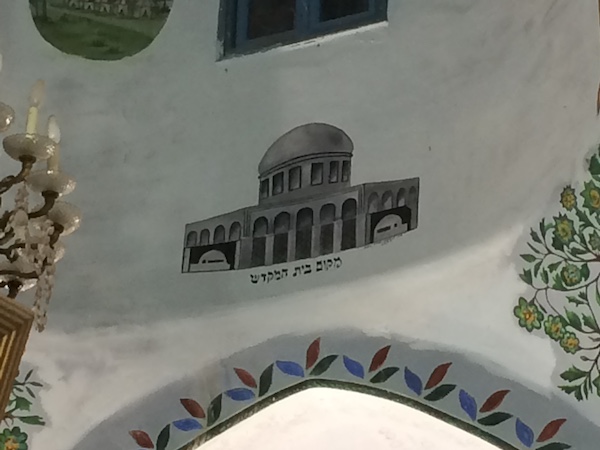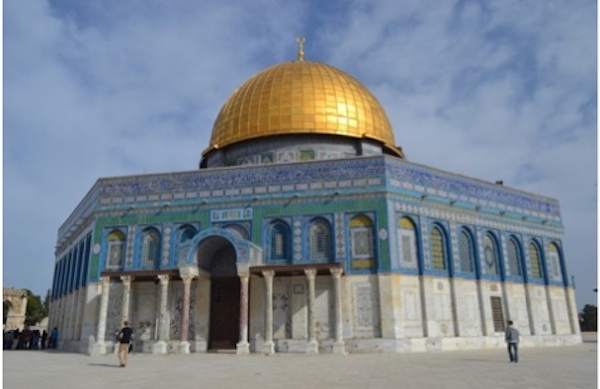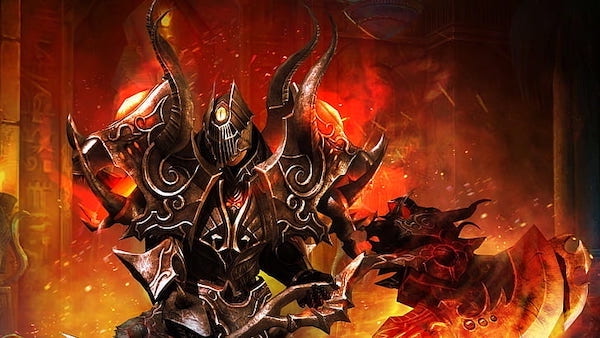The Last Tisha B’Av: A Tale of New Temples
By Rabbis Arthur Waskow & Phyllis Berman
From The Shalom Report, The Shalom Center
[ In the Abuhav synagogue in Tz’fat (Safed) there is actually on the ceiling a painting of the Dome of the Rock, built by Muslims in that extraordinary place that both Muslims and Jews view as holy — above the rock where Isaac or Ishmael was bound for offering; above the rock from which Muhammad began his mystical ascent to Heaven.

[The Dome in its amazing beauty and the Western Wall in its crouching power remind us in different ways of the Divine Presence that remains and radiates here. It resonates despite the destruction of the Jewish Holy Temples on Tisha B’Av, the 9th day of the mid-summer moonth of Av. In the season of burning heat, these microcosms of the Earth were burned — one by the Babylonian Empire and Army in 586 BCE, and its successor by the Roman Empire and Army in 70 CE.
[To mark the grief that suffused the community of “Godwrestlers” when the Temples were destroyed by imperial violence, the survivors initiated a full-day fast from water, food, and most other ways of taking earthy pleasure. Yet in Jewish tradition, on this very day of disaster Mashiach (Messiah) was born, but hidden away till a generation would come that is ready to make peace and eco-social justice in the world. In that day, the Messiah will rebuild the Temple of God’s Presence.
[The fast day cannot be carried out on Shabbat (the actual ninth day of Av this year). So this year Tisha B’Av is observed one day later, from the evening of Saturday, August 6, to the evening of Sunday, August 7. (We might note that August 6 is the anniversary of the bombing of Hiroshima in 1945 — the first hint that the human species and many others are in practical danger of annihilation.)
In the spirit of Messiah’s birthing, we offer this story of hope and redemption to be read on the fast day in mid-afternoon. That is when tradition says Jews who had in the morning refrained from donning the sacred boxes called t’fillin could put them on as a token that we await Mashiach. Or if you’d rather, read it during the break-fast on the evening when it ends.]
The Last Tisha B’Av
To the hills of ancient and modern Israel,
The hills of long-time and longed-for Falasteen,
Where the air is clearest and it is possible to see the furthest —
To the little town of Tz’fat, which some call Safed —
Above the Lake Kinneret in the Galilee —
Long ago there came a Chassid, visiting from afar to see his Rebbe.
Struggling up hills, over cobblestones, through narrow alleyways, the Chassid came panting, shaking, to the door of a pale and quiet synagogue.
So pale, so quiet was this shul that the pastel paintings on the wall and ceiling stood out as though they were in vivid primary colors.
As the Chassid came into the shul, he saw his Rebbe high on a make-shift ladder, painting a picture on the ceiling above the bimah.
The Chassid blinked, startled to see his Rebbe with a paint brush in his hand.
And then he blinked again. He frowned and tugged at his beard:
“Rebbe, what is this that you are painting here above the bimah? It looks like the Dome that the Children of Ishmael, the ones they call Muslims, have built above the rock where Abraham bound Isaac.
“The giant golden Dome that they have built where stood the Holy Temple. I have just come from Jerusalem… It looks…” He stopped.
The Rebbe’s eyes turned inward. “You know,” he said, “Here in Tz’fat we live in the radiance of the Kabbalists who lived and taught here many years ago. The air here is so clear and their radiance so pure that with our outer and our inner eyes we can see and see and see… so far! And I have seen…” he said, and paused. “I have seen…” he said and paused again.
“Looking and seeing, they can be so strange. For example — our sages teach us that when Mashiach comes, he will rebuild the Holy Temple in the twinkling of an eye. But often have I wondered: How can this be? Mashiach will be extraordinary, yet still a human being merely …
“But now! I have seen … Well, let me tell you: At the foot of the Western Wall, the Wall where God’s Own Presence weeps and hides in exile, I have seen hundreds of thousands of Jews gathered, singing.
“Mashiach has come! — — and they are singing, dancing, as the Great Day dawns. Women, men, together — — I could not believe it! I was not even sure” — — he glanced apologetic at his Chassid — “whether Mashiach was a wo … well, forget it.
“I can see from the sun, the heat, it is late afternoon. Yet the crowd are wearing t’fillin. The only time in all the year when Jews wear t’fillin in the afternoon is Tisha B’Av, so I can see that it is the day of mourning for our beloved Temple. But there are no signs of mourning — — except perhaps the way, the wistful way, Mashiach reaches out to touch the Wall, to tuck one last petition between the great carved stones.
“I see Mashiach speak a sentence to the crowds. I cannot hear the words, but I can see that from this voice there stirs a river. Like water from the ancient stones of Wall, I see a stream of Jews flow up the stairway that rises to the Temple Mount.
“The river of people pauses on the steps. They cluster ‘round a wrinkled, tattered piece of paper, posted above the stairway. I see it is signed by the rabbis of that day. It warns all Jews to go no further, lest by accident they walk — — God forbid! — — into the space set aside as the Holy of Holies.
“Mashiach reads. And laughs. And tears the sign to shreds. The stream of people shudders — — higher, higher.
“The crowd cascades from the stairway onto the great stone pavement of the Temple Mount. Their singing turns to the thunder of a great waterfall. They look toward the other end of the Mount — toward the great golden Dome of the Rock where Abraham bound his son for sacrifice.
“Surrounding the Dome are thousands of these children of Ishmael, these Muslims. They are not singing. They are shouting, furious, stubborn. ‘Not here!’ they shout in unison, ‘Not here!’
“‘You will not tear down our Holy Mosque to build your Jewish Temple!’
“But I can hear the crowd of Jews — — muttering, whispering, ‘Right there, yes! — — That is the place… No doubt, no doubt, the ancient studies tell us that it is the place.’
“Mashiach is quiet. The sea of Jews falls to a murmuring, falls silent. They turn to watch. Mashiach looks, gazes, embraces with fond eyes the Holy Space. Mashiach’s eyes move across the Dome, its golden glow, the greens and blues and ivories of the walls beneath it.

“I hear a whisper from Mashiach’s lips: ‘So beautiful!’
“The Muslims too are silent now. The stillness here, the stillness there — — so total that they split the Holy Mount in two.
“Mashiach raises one arm, slowly, slowly. The Muslims tense, lift knives and clubs and shake them in the stillness. The Jews tense, ready to leap forward with their picks and shovels.
“Mashiach points straight at the Dome.
“The peoples vibrate: two separate phantom ram’s horns in the silent air, wailing forth a silent sob to Heaven.
“Mashiach speaks quietly into the utter quiet:
‘This green, this blue, this gold, this Dome — — This is the Holy Temple!’
“I blink.
“For seconds, minutes, there is not a sound.
“Then I hear a Muslim shout, see him raise a knife: ‘No! No! You will not steal our Holy Mosque to make your Jewish Temple!”
“He throws the knife. It falls far short. No one stirs. The other Muslims turn to look at him. They look with steadfast eyes: no joy, no anger. They just keep looking. He wilts into the crowd; I can no longer see what he is doing.
”Mashiach steps forward, one step. Everyone, Jew and Muslim. breathes a breath. One Jew calls out: ‘You must not do this. You must not use their dirty place to be our Holy Temple. Tear it down! — — We need our own, the Prophets teach how wide and tall it is to be. It is not this thing of theirs, this thing of curves and circles.
“He takes a step toward Mashiach, lifts an axe to brandish it.
“The man beside him reaches out a hand and takes the axe. Just takes it. There is a murmur. but the murmur dies. The man holds the axe level in both hands, walks out with it into the no-man’s land between the crowds. He lays it on the pavement next to the Muslim knife, he backs away.
“There is another time of quiet. Two Muslims reach out from the crowd, toss their knives to land next to the axe. The pause is shorter this time. Then on every side weapons come flying through the air to land beside the axe, beside the knives. There is a pile. Somehow — I could not see how — there lights a fire. The pile begins to burn. The flames reach up and up and up — to Heaven.

“So I have seen,” the Rebbe said, “Mashiach build the Temple in the twinkling of an eye. And that is why I am painting this Dome upon our ceiling.”
The visitor took breath again. “And why?” he said. “Why would Mashiach do this dreadful thing?”
The Rebbe put his arm around his Chassid’s shoulder.
“You still don’t see?” he said. “Even here in Tz’fat, you still don’t see?
“I think Mashiach had four reasons:
“First for the sake of Abraham’s two families.
“Second for the sake of the spirals, twirling in the Dome.
“Third for the sake of the Rock beneath the Dome.
“And fourth for the sake of the twinkling of an eye.”
”And Rebbe — why did the people burn their weapons’?”
“For the sake of the burnt offering. It is written that when the Temple is rebuilt, there must be burnt offerings. And it is also written, ‘Choose!’
“Choose what? Choose what to burn:
“Each other, and the Temple, yet again?
“Or — — the things we use to burn each other with.”
“So …” said the Chassid, “… dear Rebbe — you are saying that the Dome — it really is our Temple?
“Forgive me, Rebbe, but I have a different seeing. Where they raised up the burnt-offering I think must be the Temple. The empty space. The empty space where the offering went up in flames to Heaven.
“The empty space between them, where they burned the weapons — — perhaps that is the Temple?
“Ours and theirs?”
The Rebbe turned, astonished, to gaze more deeply into the Chassid’s eyes.
And then together, each with an arm around the other’s shoulder, together they walked to where their eyes could look:
Far, far beyond the hills, much farther than the Lake they call Kinneret.
Return to NEWS
Shem Center for Interfaith Spirituality
708 North Harvey Avenue
Oak Park, IL 60302
(708) 848-1095
shemcenter1993@gmail.com
Photo Credits: Emory Mead, Stephen B. Starr, Joseph Kilikevice
The Shem Center for Interfaith Spirituality website is awarded a 2022 American Digital Design Award for excellence in design and user experience.
